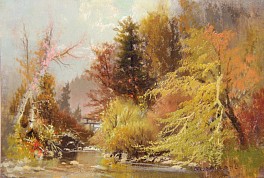BIOGRAPHY

1848-1909
GEORGE HERBERT McCORD
(1848-1909)
Born on August 1, 1848 in Manhattan, New York, George Herbert McCord was considered a central figure of the second generation Hudson River painters. While McCord described himself as mostly self-taught, he attended the Hudson River Institute and the Claverack Academy in New York. He also spent time studying in the studios of Samuel Morse and Scottish born painter James Fairman. It wasn’t long before McCord’s talents earned him space in an exhibition at the National Academy of Design in 1870. In 1874 McCord wintered in St. Augustine, Florida painting in the company of Martin Johnson Heade, George Inness, Frank Shapleigh, Otto Bacher and John Bunyan Bristol.
During his life McCord would set his easel in Paris, Venice, Scotland, throughout New England, Canada, Florida, and the Upper Mississippi, but the most publicized trip of his career was when he was invited to participate on a tour to the Grand Canyon in 1910. In celebration of the unfolding of the American West, the Santa Fe Railroad and the American Lithographic Company arranged for a well-publicized train trip from Chicago to The Canyon. The beloved American artists on the trip were treated like celebrities. One reported publicity stunt described the artists, upon arrival at the Canyon, as being lead to the rim with their eyes closed. When they opened them they were stunned by the magnificent beauty at their feet and rushed to record it in the studios built along the rim. Nina Spaulding of the Toledo Art Museum was on the tour and wrote of the historical significance of the artists’ venture: “Never before had so large a group of serious artists made such a pilgrimage to the Far West with the avowed intention of studying a given point of their own country.” The resulting paintings, together with Grand Canyon views by E.J. Dressler (1859-1907), George Innes Jr. (1853-1926), George McCord (1848-1909), William Ritchel (1864-1948), and Joseph Henry Sharp (1859-1953) were exhibited around the country.
McCord would go on another publicity trip during his life when he was invited to paint scenes along the Erie Canal. His skill and reputation would also earn him a commission from Andrew Carnegie to paint the scenery around his castle in Cluny, Scotland.
During his lifetime McCord won medals from the New Orleans Exposition, the Mechanics Institute of Boston, and the St. Louis Exposition. He was a regular exhibitor at the National Academy of Design, the Brooklyn Art Association, and the Pennsylvania Academy of the Fine Arts. Today, his work can be found at The Brooklyn Museum of Art, the Hudson River Museum, and the Museum of Fine Arts, Houston, Museum of Fine Arts in Boston, and the Metropolitan Museum of Art in New York.
